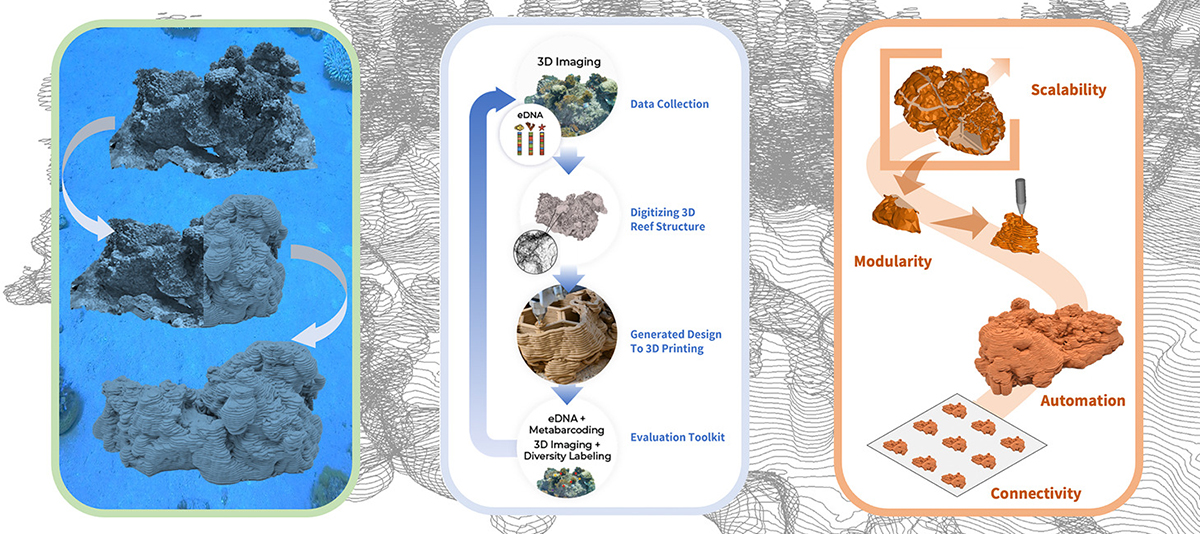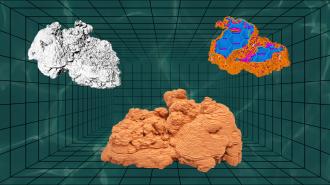A new method for designing and 3D printing custom artificial coral reefs could make them more accurate stand-ins for the natural kind, which are currently dying at an alarming rate.
Underwater ecosystems: Corals are marine animals that usually live in colonies with hundreds or thousands of other corals just like them. Some species of coral secrete calcium carbonate, and hardened layers of this substance form the basis for coral reefs.
Coral reefs cover less than 2% of the ocean floor, but about 25% of all marine life depends on them for shelter and food. Reefs are also important for people, protecting our coastlines and providing us with food, jobs, and medicine.
Artificial coral reefs: Coral reefs are dying at an alarming rate — since 1950, half of the ocean’s living coral coverage has disappeared due to ocean warming, overfishing, pollution, acidification, and other factors.
“Existing artificial reefs have difficulty replicating the complexity of coral habitats.”
Natalie Levy
To encourage the development of thriving new reefs, humans will sometimes create artificial reefs, using everything from concrete to sunken ships as a replacement for the hardened calcium on which natural reefs develop.
But because these artificial reefs can be radically different from the natural calcium reef skeletons created by coral, they aren’t a one-to-one replacement.
“Existing artificial reefs have difficulty replicating the complexity of coral habitats and hosting reef species that mirror natural environments,” said Natalie Levy, a PhD student at Bar-Ilan University.
Fake it till you make it: Levy and Bar-Ilan professor Oren Levy partnered with researchers from the Israel Institute of Technology, Tel Aviv University, and the University of Haifa to create realistic artificial coral reefs that can be customized for any location.
“You can take out the core characteristics of that reef that you’re interested in replicating and create an artificial reef for your model.”
Natalie Levy
For their study, they first analyzed thousands of images of the coral reefs off the coast of Eilat to determine how the structure of a reef relates to species diversity. Next, DNA was extracted from samples of the reef environment to determine the variety of creatures inhabiting it.
This data, along with other information, was fed to an algorithm to produce an interactive 3D model that can be adjusted to meet the needs of whatever location is going to be home to an artificial reef.
“You can take out the core characteristics of that reef that you’re interested in replicating and create an artificial reef for your model. So, that can be the complexity of the reef, the shape, the design, all these factors,” Levy told NoCamels.

The final step is 3D printing the reef out of a ceramic material.
“Three-dimensional printing with natural material facilitates the production of highly complex and diverse units that is not possible with the usual means of mold production,” said research co-leader Ezri Tarazi.
The researchers are now installing several of their 3D-printed artificial coral reefs in the Gulf of Eilat to find out how they fare in the real world.
The big picture: Artificial coral reefs aren’t our only hope for protecting the important ocean ecosystems.
Researchers are also exploring ways to make reefs more resistant to climate change — some are seeing promising results from dosing corals with probiotics, while others are using the gene-editing technology CRISPR to create corals that tolerate higher temperatures.
“These interventions have the potential to help get the reef to a sustainable future.”
Daniel Harrison
To draw fish to dying reefs, UK researchers are playing the sounds of healthy reefs through underwater speakers, and off the coast of Australia, scientists are literally creating clouds to produce protective shade over the Great Barrier Reef.
The best thing we can do for the world’s coral reefs, though, is address climate change.
“This is a race against time,” Daniel Harrison, leader of the artificial cloud project, told the Guardian in 2020. “If we can go really hard on emissions and meet or beat the Paris [climate] targets, then these interventions have the potential to help get the reef to a sustainable future — but only under that very aggressive emissions reduction scenario.”
We’d love to hear from you! If you have a comment about this article or if you have a tip for a future Freethink story, please email us at [email protected].






